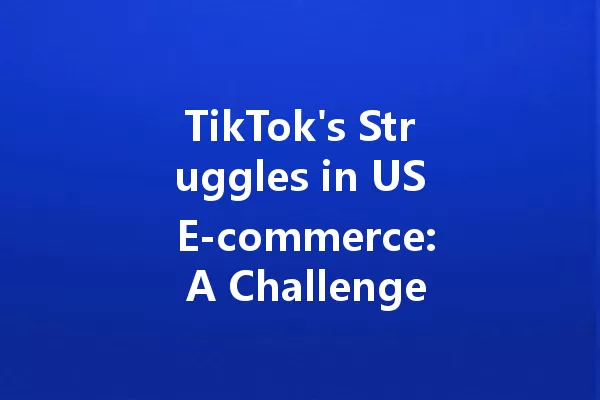
The rise of TikTok as a powerful social media platform has not only transformed how people consume content but also how brands market their products. However, despite its popularity and the unique engagement it fosters, TikTok faces an uphill battle in establishing itself in the U.S. e-commerce scene. Why? There are several layers of complexity involved, ranging from competition to market dynamics.
Competitive Landscape
TikTok entered a crowded marketplace dominated by established giants like Amazon, eBay, and Shopify. These platforms have spent years perfecting their logistics, payment systems, and consumer trust. TikTok, on the other hand, is still in the process of figuring out how to convert its vast user base into paying customers. The strategy relies significantly on leveraging its engaging video content, but transforming passive views into active purchases can be a tricky transition.
Many brands are experimenting with TikTok’s potential, launching innovative campaigns that playfully capture the essence of the platform. However, the challenge remains in achieving a seamless shopping experience from content view to checkout.
User Engagement and Shopping Experience
What sets TikTok apart is its user interaction. The platform has succeeded in creating a community where users not only watch but also create content that resonates with their peers. This is a double-edged sword when it comes to e-commerce. 
On one hand, the community vibe fosters authenticity—consumers are more likely to trust a product that appears in a relatable video tutorial or a fun dance challenge than a traditional ad. On the other hand, the format primarily focuses on entertainment rather than commerce. Users often scroll for entertainment, not for shopping. So, how can TikTok leverage user-generated content to drive sales?
The Importance of Influencer Partnerships
Influencers have become the backbone of TikTok’s marketing strategy. Brands collaborate with these creators who can showcase their products in an organic way that aligns with the app’s ethos. This strategy can significantly influence consumer behavior, as followers often look to influencers for recommendations.
For example, a beauty brand may send its latest products to popular beauty influencers who create tutorials and reviews. This not only boosts brand visibility but also offers consumers relatable use cases. However, the key challenge here is measuring the return on investment (ROI) from such influencer partnerships.
How do brands track the effectiveness of their expenses? Often, they look at engagement metrics and sales conversions, but direct tracking can be murky.
Challenges Ahead: Regulatory Issues and Consumer Trust
As TikTok grows, so does the scrutiny it faces. With increasing regulatory challenges around data privacy, TikTok has to navigate a complex landscape while maintaining consumer trust. In an environment where users are more aware of data privacy issues, transparency becomes paramount.
If consumers don’t feel secure using the platform for shopping, they may refrain from making purchases. Brands, too, become cautious about aligning themselves with a platform that could be viewed as an insecure venue for transactions.
| Challenge | Impact on E-commerce | Solutions |
|---|---|---|
| Regulatory Compliance | Consumer trust issues | Enhancing transparency |
| Market Competition | Losing potential sales | Innovative marketing campaigns |
| Conversion Rates | Low purchase rates | Streamlining the shopping experience |
The Road Ahead
While TikTok’s potential in the U.S. e-commerce market is undeniable, overcoming existing challenges will require innovative thinking and consumer-centric strategies. By harnessing the platform’s strengths—like creativity and community—brands can make the most of this unique marketplace. As the platform experiments with in-app shopping features and fine-tunes its advertising strategies, keeping consumers engaged and secure in their shopping experiences will be key.
Navigating these challenges could redefine the landscape, turning TikTok into a formidable player in online retail. The question remains—can TikTok marry its entertainment roots with effective e-commerce to carve out a winning strategy?
Brands tapping into TikTok’s vibrant platform have a fantastic opportunity to connect with younger audiences in a way that feels genuine and relatable. Collaborating with influencers who embody the brand’s identity can amplify reach and engagement. Influencers know their audience and can present products in a natural context, making it easier for their followers to envision themselves using those items. This organic approach is key; rather than pushing a hard sell, influencers can weave products into their narratives, showing how they fit seamlessly into everyday life.
Storytelling is a powerful tool on TikTok. Brands should focus on crafting narratives that resonate with users’ experiences or aspirations. Visually engaging and authentic content holds viewers’ attention, encouraging them to interact, comment, and share. When brands can narrate a story or showcase an experience that aligns with the values and lifestyle of their audience, it creates a deeper connection. Integrating products within these stories instead of treating them as mere advertisements leads to more meaningful engagement, ultimately translating into higher visibility and better sales potential.
Frequently Asked Questions (FAQ)
What challenges does TikTok face in the U.S. e-commerce market?
TikTok struggles with intense competition from established e-commerce platforms, regulatory scrutiny, and the challenge of converting user engagement into actual purchases. Building consumer trust and creating a seamless shopping experience are also significant hurdles.
How can brands effectively use TikTok for marketing?
Brands can leverage TikTok’s unique video format by collaborating with influencers and creating authentic, engaging content. Using relatable storytelling and integrating products naturally within the content can resonate well with the audience, leading to better engagement and potential sales.
What role do influencers play in TikTok’s e-commerce strategy?
Influencers are crucial in TikTok’s marketing strategy, as they help create organic content that showcases products in an engaging manner. Their recommendations can significantly sway consumer decisions, but tracking the effectiveness of these partnerships can be challenging for brands.
How does TikTok ensure consumer data privacy amidst regulatory challenges?
TikTok is actively addressing regulatory scrutiny by enhancing its transparency measures and implementing robust data protection policies. Building consumer trust through clear communication about data usage and security is essential for its e-commerce growth.
What future innovations might we see from TikTok regarding e-commerce?
As TikTok continues to evolve, we may see new shopping features integrated into the platform, such as enhanced in-app purchasing, live shopping events, and more features that allow brands to interact and engage with their audience directly, making the shopping experience more convenient and immersive.
内容结尾插入,支持HTML代码,如果不需要请删除